インストール
Installation Guide
図入りのPDF版をご覧になりたい方は以下のリンクをクリック
A PDF version with illustrations is available at the link below.
Installation Guide.pdf
1. ディスクイメージの準備
Preparing the disk image
Download and unzip the disk image.
2. 起動ディスクの準備
Writing the image on micro SD card
Prepare a microSD card with a capacity of 2GB or more, and initialize it with SD Memory Card Formatter.
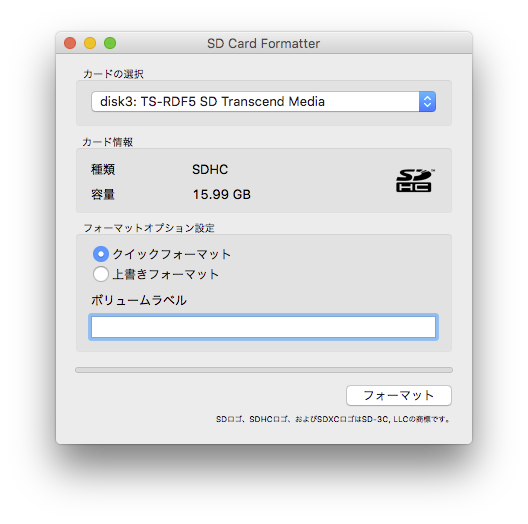
balenaEtcher やWin32 Disk Imager などでイメージを書き込みます。
Write the image with balenaEtcher or Win32 Disk Imager on a microSD card.

3. スレーブモードとマスターモードについて
Explanation of slave mode and master mode
Many I2S HAT cards operate in slave mode. The term "slave" here means that the digital data supplied from the Raspberry Pi to the I2S HAT card is supplied based on the clock generated by the Raspberry Pi.
対して一部のI2S HATカードは自らオシレーターを搭載し、I2S HATカード上のオシレーターが生成したクロックをRaspberry Piに供給し、そのクロックにもとづいてRaspberry PiからI2S HATカードにデータを供給させています。こうした駆動方法を「マスターモード」と呼びます。
On the other hand, some I2S HAT cards have their own oscillators, and can supply the clock generated by the oscillator on the I2S HAT card to the Raspberry Pi. These I2S HAT cards are supplied with data from the Raspberry Pi based on the clock generated by themselves. Such a driving method is called “master mode”.
4. Raspberry Pi の起動
Start Raspberry Pi
Set microSD card in Raspberry Pi and start Raspberry Pi.
The LED on the back of the Raspberry Pi will automatically turn off after the startup process is complete.
5. NAS の設定
NAS settings
*Display SETTING panel*
ウェブブラウザに“smpd.local” と入力し、symphonic-mpd のWebUI を表示させます。WebUI 右上の歯車アイコンをクリックしプルダウンメニューを表示させ、“SETTINGS” を選択します。
Enter “smpd.local” in the web browser to display the symphonic-mpd WebUI. Click the gear icon at the top right of the WebUI to display the pull-down menu, and select “SETTINGS” .

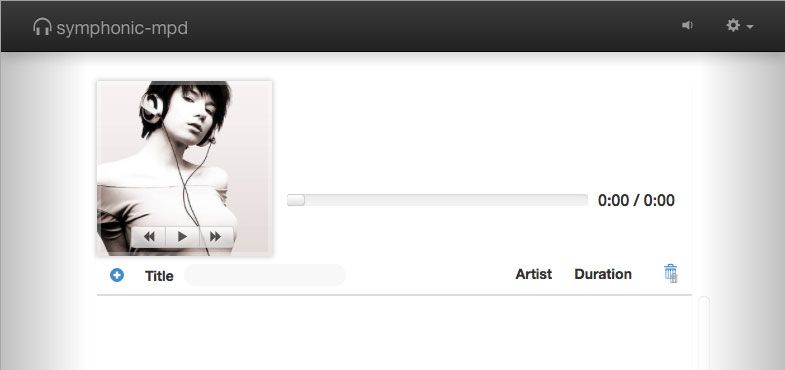
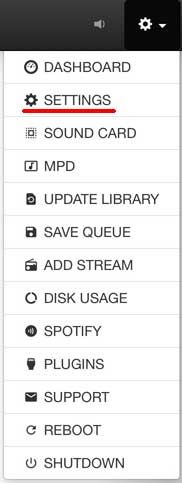
5.2 NAS 情報の入力
Enter NAS information
表示される“Settings”パネルの下部に“NAS Setting”があります。“path”に認識させるNAS のパスを、“username” と“password” には、NAS で設定しているユーザー名とパスワードを入力します。最後に“OK” ボタンを押します。
※補足
NAS のパスは原則 //「NASのIPアドレス」/「読み込み対象の楽曲ディレクトリ」の形式で指定して下さい(なお、本システムではIPv6は使用できません)。
例:NASのIPアドレスが 192.168.1.1
読み込み対象の楽曲ディレクトリが qmultimedia/music/
の場合
path //192.168.1.1/qmultimedia/music/
You can see “NAS Setting” at the bottom of the “Settings” panel. Enter the path of the NAS to be recognized in “path” , and the user name and password, which are set in the NAS, in “username” and “password” . After entering all the information, press the “OK” button.
Appendix:
You shuld input path phrase with this phrase // "NAS IP addr " / "path to your music directory" (And this system does not support ipv6, only support ipv4).
Example:
your NAS IP addr 192.168.1.1
your NAS's music directory's path qmultimedia/music/
you should input in path phrase
//192.168.1.1/qmultimedia/music
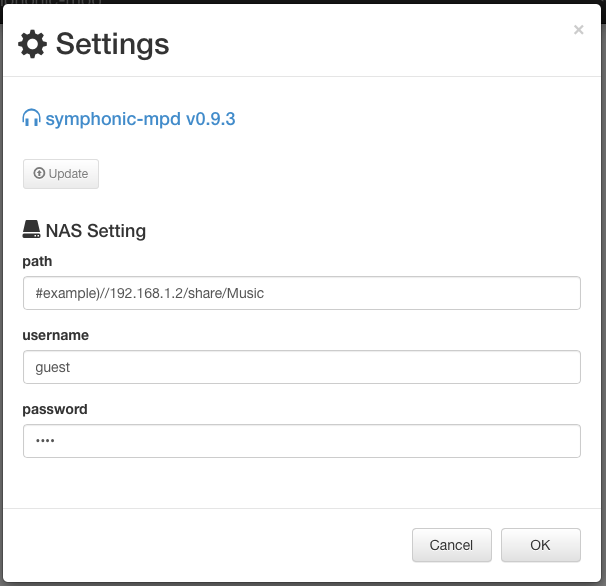
5.3 設定の反映
Settings are reflected
“network performance tuning” パネルが表示されます。“NAS setting succeeded” と表示されれば、設定完了です。“OK” ボタンをクリックしてください。symphonic-mpd がNAS を認識し、設定が完了するまで、約30 秒ほどかかります。
注意:NAS との接続はCIFS で行っています。NFS はサポートしておりません。
The “network performance tuning” panel is displayed. If “NAS setting succeeded” is displayed, the setting is complete. Click the “OK” button. It takes about 30 seconds for symphonic-mpd to recognize the NAS and complete the settings.
Note: Connection to the NAS is done with CIFS only. NFS is not supported.
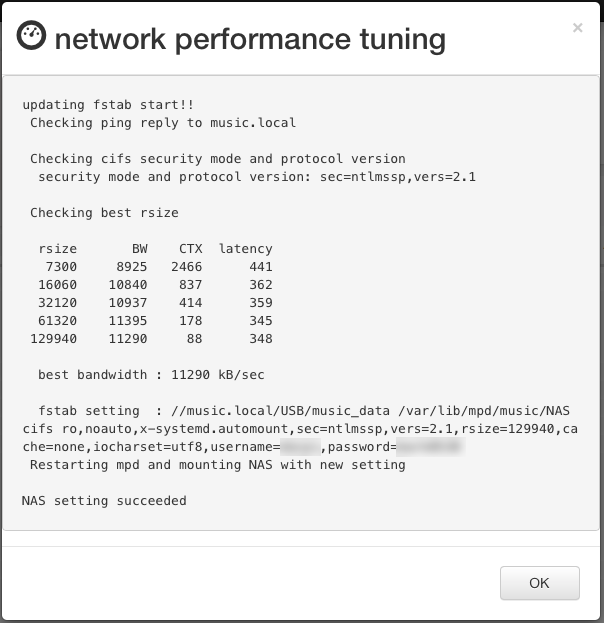
6. サウンドカードの設定
Sound Card Setting
Click the gear icon in the upper right corner of the WebUI to display a pull-down menu, and select “SOUND CARD”.
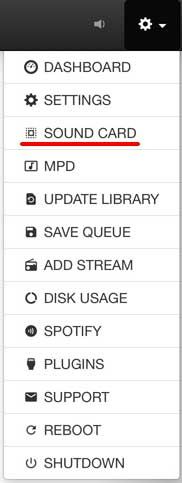
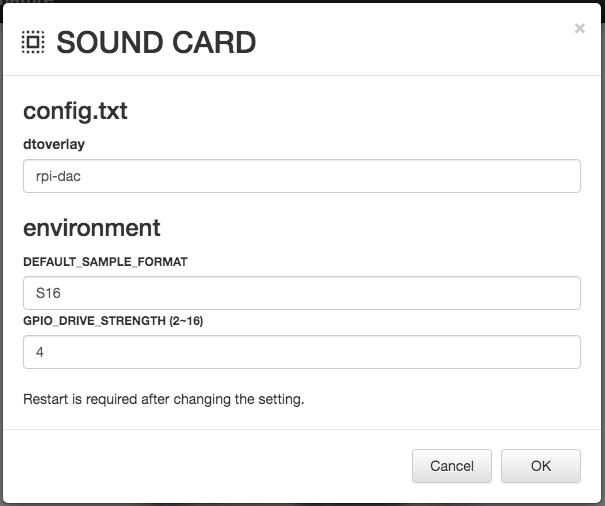
表示される「SOUND CARD」パネルのdtoverlayの欄に、使用するI2S HATカードに対応するドライバーを入力します。入力するドライバーはI2S DAC 対応表で確認してください。
Enter the driver corresponding to the I2S HAT card you use in the "dtoverlay" field of the "SOUND CARD" panel that appears. Check the driver to be input in the I2S DAC compatibility table.
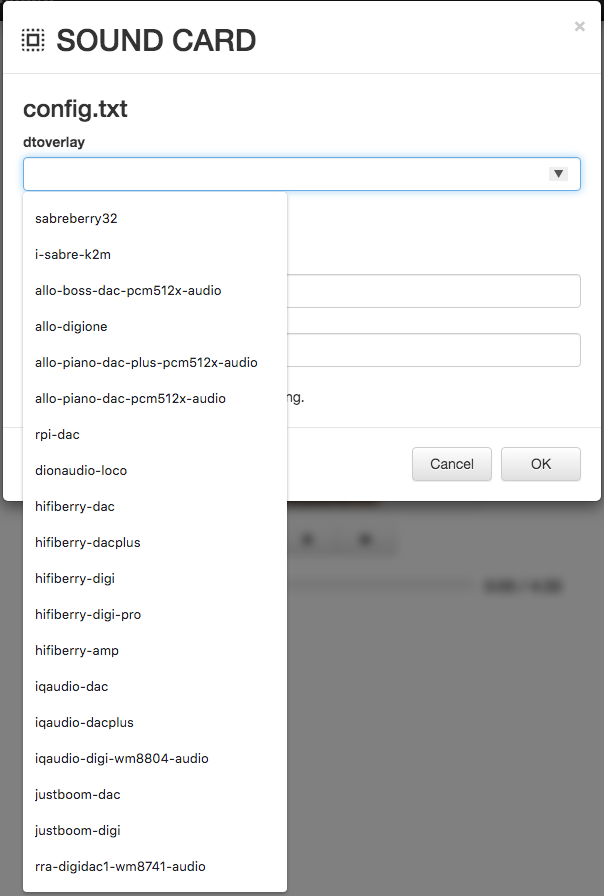
通常「environment」の入力値は、初期値のままでかまいません。SabreBerry32など、一部のI2S HATカードは、“DEFAULT_SAMPLE_FORMAT”で“S32”を選択します。これはAirPlayやSpotify Connect再生時のビット深度を指定するものです。
Normally, the input value of "environment" can be the default value. Some I2S HAT cards, such as SaberBerry32, select “S32” for “DEFAULT_SAMPLE_FORMAT”.
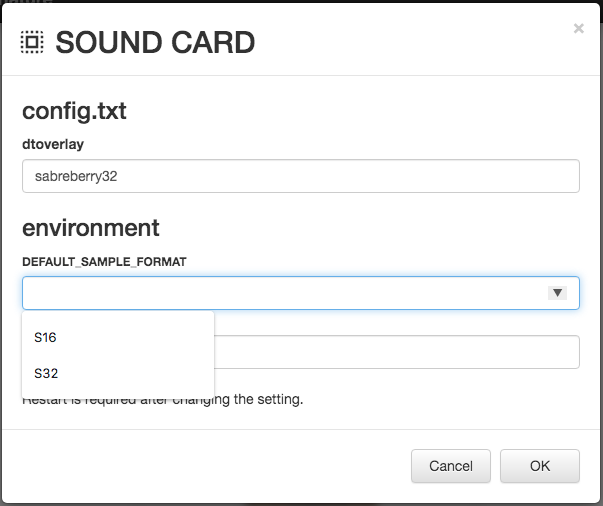
入力後、「OK」ボタンをクリックし、Raspberry Piを再起動させることで、入力内容がシステムに反映されます。この再起動時から、I2S HATカードは起動音を出力するようになります。
Some I2S HAT cards, such as SaberBerry32, also require inputs to "environment". After inputting, click the "OK" button and restart Raspberry Pi to reflect the input contents on the system. From this restart, the I2S HAT card will output the startup sound.
7. SoX Resamplerの設定
SoX Resampler Set Up
Click the gear icon in the upper right corner of the WebUI to display a pull-down menu, and select “MPD”.
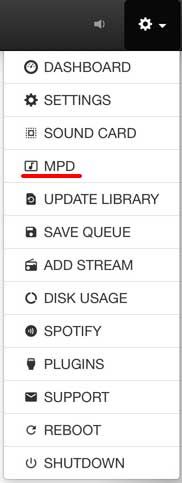
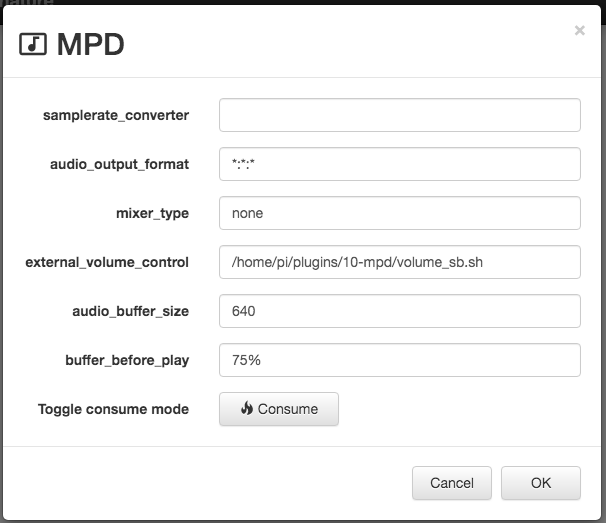
7.1 samplerate_converter
SoX Resamplerの変換品質を設定します。選択肢は、“soxr very high”、“soxr high”、“soxr medium”、“internal”の4種です。SoX Resamplerを利用しない場合は、入力欄を空白のままにするか、“internal”を選択します。
Set the conversion quality of SoX Resampler. The choices are “soxr very high”, “soxr high”, “soxr medium”, and “internal”. If you do not use SoX Resampler, leave the input field blank or select "internal".
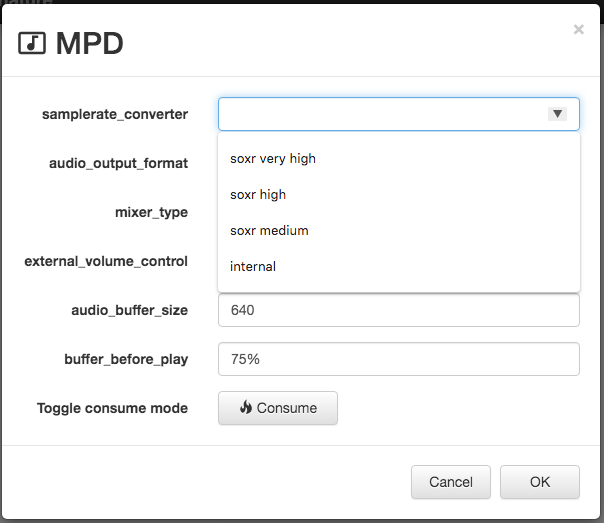
注:I2S HAT カードのサプライヤーからの指定がない限り、“samplerate converter” の入力欄は空白のままにするか、“internal” を選択することを推奨します。なぜなら、ソフトウェアでリアルタイムに処理できる程度のリサンプリング処理は、音質を悪くすることはあれ、良くすることはないからです。
Note : Unless otherwise specified by the I2S HAT card supplier, we recommend that you leave the "samplerate converter" input field blank or select "internal". The reason is that resampling processing that can be processed in real time by software does not improve the sound quality, although it may deteriorate the sound quality.
注:SabreBerry32 ユーザーは“internal” を選択してください。詳しくは「よくある質問と答え」の「SabreBerry32 をマスターモードで使用したい」を参照してください。
Note : SaberBerry32 users should select "internal" in the "samplerate converter" input field. For more information, see "I want to use SabreBerry32 in master mode" in "Frequently Asked Questions".
7.2 audio_output_format
SoX Resamplerが有効になっている場合、ここで設定したフォーマットに変換されます。入力フォーマットは「サンプリングレート」、「ビット深度」、「チャンネル数」の3つの設定値をコロンで連結した文字列となります。例えば、サンプリングレート:44.1KHz、ビット深度:32bit、ステレオの場合、入力値は44100:32:2となります。数値の代わりに*も設定できます。この*は、指定される数値が変換対象外であることを意味します。上記の例をとって「サンプリングレート」と「チャンネル数」を変換対象外に指定する場合、入力値は*:32:*となります。なおSoX Resamplerを有効にするしないにかかわらず、この項目を空欄のままで設定することはできません。SoX Resamplerを利用しない場合は、*:*:*と設定しておきましょう。
If SoX Resampler is enabled, it will be converted to the format set here. The input format is a string in which the three setting values of "sampling rate", "bit depth", and "number of channels" are concatenated with a colon. For example, if the sampling rate is 44.1KHz, the bit depth is 32bit, and the stereo, the input value is44100: 32: 2 . * can be set instead of a numerical value. This* means that the specified number is out of the conversion target. If you specify "Sampling rate" and "Number of channels" to be excluded from the conversion in the above example, the input value will be *: 32: *.
Note that this item cannot be left blank, regardless of whether SoX Resampler is enabled. If you do not use SoX Resampler, set *: *: * .
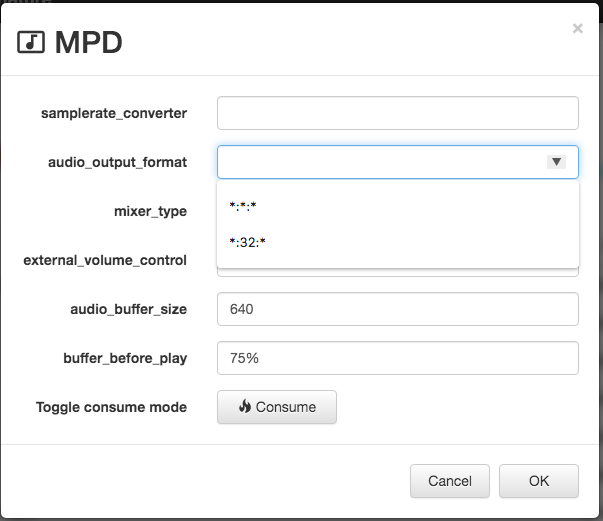
注:SabreBerry32ユーザーは *:32:* を選択してください。詳しくは「よくある質問と答え」の「SabreBerry32をマスターモードで使用したい」を参照してください。
Note : SaberBerry32 users should select *:32:* in the "audio_ouput_format" input field. For more information, see "I want to use SabreBerry32 in master mode" in "Frequently Asked Questions".
8.ボリュームの設定
Volume Set Up
設定値は“hardware”、“software”、“none”の3種類です。初期値は“none”で、ボリュームスライダー機能は無効になっています。
The setting values are "hardware", "software", and "none". The default value is “none”, and the volume slider function is disabled.
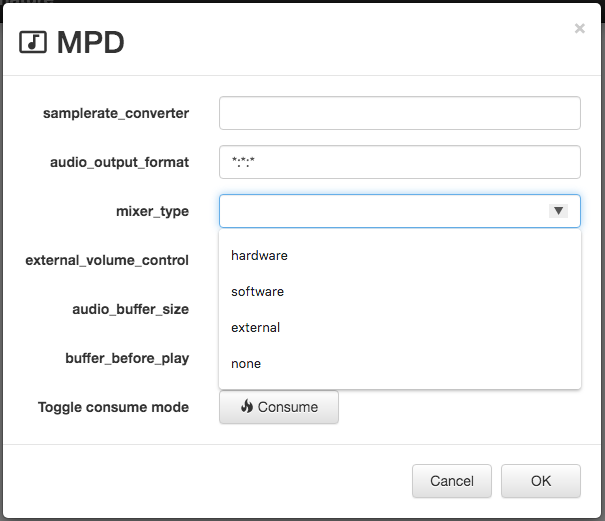

“software”を設定することで、ソフトウェアボリュームを利用できるようになります。
By setting “software”, you can use the software volume.

ただしソフトウェアボリュームでは、ボリュームを絞ることで再生音の品質が低下する可能性があります。
However, with software volumes, reducing the volume may reduce the quality of the playback sound.
SabreBerry32、Terra-Berry DAC2ユーザーは“hardware”を設定することで、ハードウェアボリュームを利用可能になります。
*SaberBerry32 and Terra-Berry DAC2 users can use the hardware volume by setting “hardware".
9. その他の設定
Other Settings
9.1 audio_buffer_size
初期値のまま使用して問題はありません。
ネットワークの品質に問題がある環境では、バッファサイズを大きくすると再生が安定する可能性があります。ただし、バッファを大きくすると音質は悪化しやすくなります。L2キャッシュを圧迫しないよう、慎重に引き上げるべきです。
There is no problem using the default value.
In environments where there is a problem with network quality, increasing the buffer size may result in stable playback. However, increasing the buffer size increases the likelihood that the quality of the playback sound will deteriorate. You should raise it carefully to avoid squeezing L2 cache of Raspberry Pi.
9.1 buffer_before_play
“audio_buffer_size”と同様です。
初期値のまま使用して問題はありません。
Same as “audio_buffer_size”.
There is no problem using the default value.
10. 楽曲データベースの構築
Recognize songs on NAS
Click the gear icon in the upper right corner of the WebUI to display a pull-down menu, and select “UPDATE LIBRARY” .
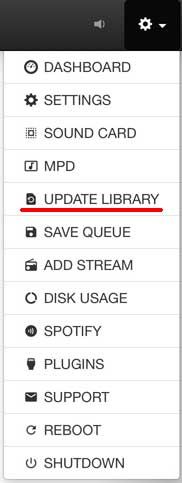
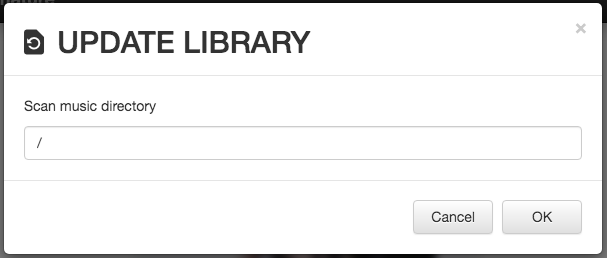
UPDATE LIBRARY選択後に表示される「UPDATE LIBRARY」パネルではテキストボックスに「/」が表示されていますが、そのままOKを押して下さい。その後、ダイアログは消えますが「Library Update Started」という緑色のメッセージが画面左下に表示されたらデータベースの構築をバックグラウンドで実施しています。
*データベースの構築にはある程度の時間がかかります。
In the "UPDATE LIBRARY" panel that appears after selecting "UPDATE LIBRARY" from the pull-down menu, "/" is displayed in the text box, but you can simply press the "OK" button. After that, the dialog disappears, but when the green message "Library Update Started" is displayed at the bottom left of the screen, the database is being built in the background.
Note : It takes some time to build the database.
11. ネットワークの設定
Configure the NETWORK
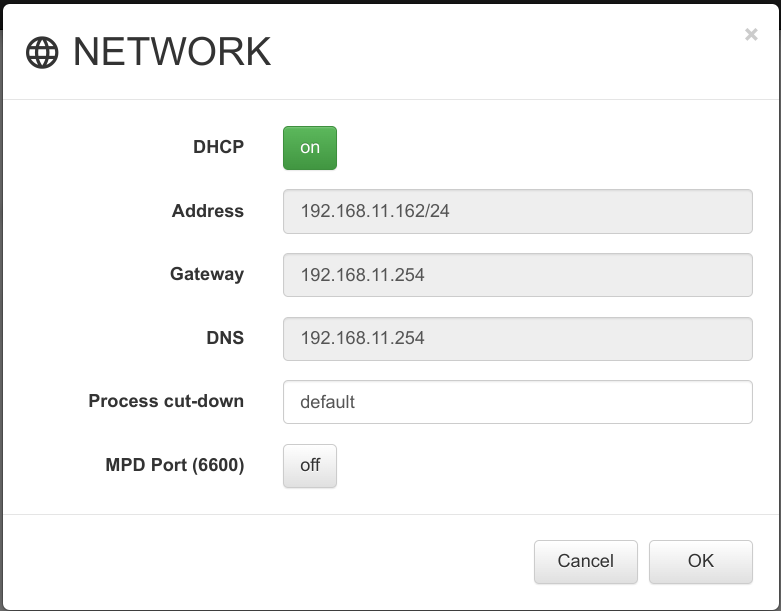
まず、DHCPによるルータから自動でIPアドレス付与+Gateway, DNS 自動設定を希望する場合は DHCP を "on" にして下さい。
Raspberry Pi に手動IPアドレスを付与する際は DHCP を ”off" にして下さい。
(DHCP が on の場合、Address・Gateway・DNSのテキストボックスは編集不可となります。)
手動IPアドレスを付与する場合、以下の通り入力して下さい。
| 項目 | 詳細 |
|---|---|
| Address | 手動IPアドレス+サブネットマスクを入力 本システムではipv4のみ対応 IPアドレス+サブネットマスクは ***.***.***.***/**方式での入力のみ対応します |
| Gateway | インターネットに接続する際のルータのIPアドレスを指定 インターネット接続はオンラインアップデート時やカバーアートの問い合わせ、last.fmでのScrobble等に使用 |
| DNS | インターネットに接続する際のURL名前解決時に使用するサーバのIPアドレスを指定 |